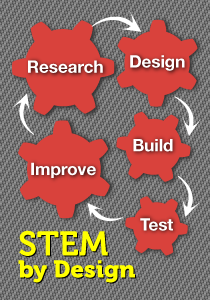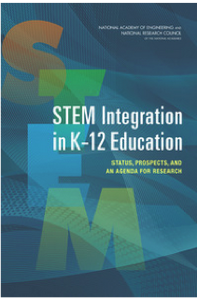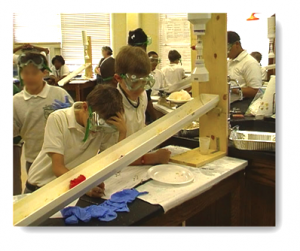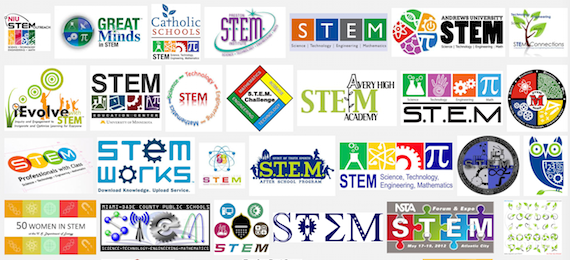STEM 2015: Are We Losing Our Focus?
A MiddleWeb Blog

I decided to scrutinize what’s being described as “STEM” these days using resources from the National Academies and the American Society for Engineering Education, as well as my own work with the Engaging Youth through Engineering project.

► Successful STEM Education Programs (National Research Council)
► Examination of Integrated STEM Curricula as a Means Toward Quality K-12 Engineering Education (Research to Practice)
► STEM Integration in K-12 Education: Status, Prospects, and an Agenda for Research (National Academies Press). [PDF]
According to studies and writings about the STEM “idea” at its onset, certain criteria and principles would be common to all STEM lessons and programs. I made a list of some of these criteria to help me weigh how well our various STEM programs today are meeting them:
✔︎ Criteria for STEM Programs
1. Focus on integrating science, technology, engineering – preferably all four, although true integration of even two would be an acceptable step toward STEM.
2. Focus on a real-world problem or engineering challenge.
3. Use Inquiry-based, student-centered learning approaches.
4. Engage students in using an engineering design process that leads to developing a product or process to solve the engineering challenge.
5. Emphasize teamwork and communication.
6. Build rich content knowledge of science and mathematics.
Note that these are not the only criteria, but according to the National Research Council, these elements should all be present in K-12 STEM curricula.
Also keep in mind that technology in STEM involves creating devices to satisfy human wants and needs. It’s not a discipline in the strict sense of the word. Engineering includes a process for solving problems and integrates science and math content to devise technologies.
STEM Schools, Plus and Minus

In reality, however, the schools implementing STEM programs with fidelity are few and far between. Most of the schools fall into one of two categories:
STEM Minus schools (STEM-). In these schools the STEM programs leave out one or more of the four STEM ingredients. Admittedly, the challenge of connecting the four (three disciplines + technology) is hard. If the job of teaching STEM falls to just one teacher, that person may lack in-depth content knowledge in both science and math to provide the necessary rigor and integration needed.
Note, however, that STEM lessons don’t necessarily teach the specific content in math and science – they may apply content that has already been taught. The key point is whether a STEM program applies math and science concepts to solve an engineering challenge and provide students with opportunities to integrate learning.
Here are examples of some STEM schools I found.
► Schools that focus only on digital technology and technical skills. Some schools are focusing on an engaging new initiative – coding – and yet claim to be teaching STEM. Those schools are actually teaching one STEM-friendly component that may be incorporated into STEM curriculum. These schools meet few if any of the Criteria for STEM programs.

► Schools focused on Maker Education initiatives. This worthwhile initiative involves kids in a great deal of personal exploration and innovation based on their interests. When correctly implemented, the Maker approach makes for highly engaged learners. Maker projects, however, are not intended to substitute as STEM programs. They frequently accomplish Criteria #2 and #3 and touch on other criteria to some degree. But their goals and focus differ from STEM.
► Schools focused on robotics. These schools may or may not offer true STEM programs, depending on whether or not the robotics program meets the STEM criteria. Some robotics classes are highly directive, with kids following a prescribed procedure for building robots. Some are a great deal like Maker projects, with students having freedom to create robots that interest them but without an intentional focus on math or science content. Students may work in teams or they may work alone. So to determine if your robotics program is a STEM program, or simply a good program through which students can create and invent, take a look at the Criteria for STEM programs.
STEM Plus schools (STEM+). A great many programs that can be identified as STEM+ involve other disciplines. Probably the best known example is STEAM, which adds the arts to the original four ingredients of STEM. (Not a bad idea, since understanding how to create attractive and appealing products is important in the engineering world. When included strategically, arts fit naturally.)
Then we have STREAM (+ reading and art), STEMM (STEM + Medicine), STEMSS (STEM + social studies), and even STREAMSS (STEM + just about everything.) It would be difficult to tell if these STEM+ programs meet STEM criteria because the program elements are scattered throughout the curriculum.
Remember, STEM as originally conceived is intended to get kids up to speed on science and math using an engineering design approach, emphasizing teamwork and real-world problems.
So Where Does STEM Stand?
A recent Education Week topic asks, Is STEM Too Broad a Category? I have that concern when we see other coursework becoming part of STEM. Can juggling other coursework give short shrift to STEM subjects that were the initial focus of the initiative? And, we already have a perfectly fine initiative that does integrate all subjects –project based learning (PBL). Are we trying to reinvent PBL and call it STEM – possibly to the detriment of math, science, and the other subjects as well?
Goals for STEM 2015
If I had to develop a goal for STEM schools and programs in 2015, I’d recommend something like this:
Research, study, identify, and implement effective approaches for improving STEM teaching and learning in your school. Decide what STEM will be in your school and remain true to the basic criteria of STEM programs.
A lot of good STEM stuff is going on in schools. Share it, and let’s keep talking about what STEM should be and why it deserves its own place in our ever-expanding school curriculum.



































Thank you, Anne. Way overdue and thoughtful approach to STEM.
I am glad you found this on track, Thom. Thanks for your comment.
We have partnered with TPS Publishing to move our STEM curricula into the mainstream. Our curriculum has now been approved for state-wide adoption for K-5 mathematics in FL and GA, K-8 mathematics in CA and NC, and K-8 mathematics and K-8 science in TX. TPS is the only program that specifically includes STEM approved in any of these states. But, it is very difficult to get a school district to shift from traditional textbooks from well-established publishers. Even so, the schools that have piloted our curriculum have been pleased with the results and we are seeing increased interest. Maybe the age-old question “when are we ever going to use this stuff?” will go the way of dinosaurs and floppy discs.
Hi, Brad. Has the Center for Mathematics, Science, and Technology at ISU partnered with TPS to produce a STEM curriculum? That’s terrific. Feel free to publish a link to that curriculum. I’m especially impressed and delighted that it is not textbook-driven. You are right about schools having a hard time giving up that traditional textbook approach (shudder).
Technology Education should be one of the alternatives talked about in this article. Design based, engineering, using knowledge, whether it be science, math or another +. ITEEA.org. Also, STEM careers should be discussed as some folks think that STEM is just making sure we focus on careers that are now in demand and earn a decent wage. I have a huge problem with STEAM/ STREAM and you touched on it nicely. Also the definition of Technology is correct: “A PROCESS to solve human needs and wants” this is the backbone of Technology Ed. Nation wide. Some see the “T” as using computers. FOR HIGH SCHOOL IDEAS SEE: http://tinyurl.com/on5lk63
FANTASTIC ANNE
Wow, Mark – you’re right about my omission of tech ed and careers in this article. Technology so often gets the short shrift when writing about middle school STEM. I think of it in connection with high school STEM (Animation, CADD, Biotech, etc.) I didn’t mention industrial tech for the same reason. Still, I need to include more info about tech ed in subsequent posts. I also like the idea of technology as a process rather than an object. I appreciate the link and will keep it bookmarked. If you have any information or resources about middle school technology, please post them for me and other readers. And thanks for your insights and gentle prodding.
Thanks Anne.
Your article illuminates many key features I believe to be integral components of STEM. I, too, have seen an increasing number of STEM programs focusing on just the M and S while ignoring the T and E. In my opinion, the T and the E are the areas that motivate students to want to learn the M and S; the T and E provide invaluable learning connections between the “real” world and the M and S, not just theoretical (often memorized) information.
Let’s get the students up out of their seats and ask them to research, design, build, test/modify, and APPLY M and S principles. Integrating STEM should be synonymous with project- and scenario-based learning environments in which students are engaged in hands-on “design and make” learning activities.
And to echo a few of Mark’s comments about technology education. For those not familiar with its evolution, technology education evolved from the old industrial arts programs of the 1970’s and 80’s by teachers who were dissatisfied with its outdated curriculum. True technology education programs could be (some say should be) called STEM programs. Technology education (not industrial arts) focuses on the integration of scientific knowledge, technological processes, design, engineering, and problem-solving for the creation of useful products. A good technology education program would be a great model for teachers interested in integrating STEM into their classrooms.
Thanks again Anne.
Chris, you and Mark are giving me some really intriguing things to think about, and have clearly pointed out the need for me to expand my thinking about middle school STEM to include technology in a different and real way. Please stay in touch. My Twitter handle is ajollygal.
Technology education started in the middle grades in NJ back in 1985 ish.
I will get our first standards document, 1996, converted into PDF and share.
Excellent article.
Locally(Victoria, Australia) technology education was intended to provide ‘work ready’ 16 year olds into manufacturing. These industries no longer exist (locally!) and the teachers with industry expertise are becoming a rare breed…
The ‘design process’ has been visible sporadically whenever connection, vocation and new technology is mentioned in the same project.
Part of the issue is getting sufficient interest in elementary(primary) schools where traditionally teachers have very little science/mathematics or technology(wood/metal/plastic-not computers)
Interestingly technology always referred to manual arts, NOT computers. However the term has been redefined.
Locally we refer to STEMx where the four main elements and anyone else interested in promoting the four elements.
Integrating STEM elements has never been an issue, any design, plan, build, test project incorporates the main ideas.
The big problem is assessment! ..the dilemma of reward for effort or results continues. Tests do not work for this endeavour…rubrics are the way to go!
STEMx – what a novel idea, Gary! I need to mull that one around in my head if the goal of “x” is to focus on the STEM subjects.
I really agree with you about the difficulty of assessment. It’s not that coming up with ways to evaluate the impact of the STEM project is hard, but rather – STEM isn’t tested by large-scale standardized multiple-choice testing – the ones that “count” in the eyes of the establishment. Rubrics are certainly preferable to that. That’s one of the next subjects I plan to tackle, although I’m feeling the call to delve deeply into the technology aspects as well.
Thanks for your comments.
Wow! Lots of food for thought here. As I work with teachers in my district and region, I find the fear of STEM is the integration of all four curricular areas at all times and in every lesson. My goal is to assuage those fears by having teachers think of STEM as best practices rather than specific curriculum. For example, when I did a workshop for literacy teachers, the focus was that literacy is “smack dab in the middle of STEM”. I shared with them some PBL ideas as well as some mini-engineering challenges that would spark discussion with their students. I totally agree with your goals! All teachers have a stake in STEM!
Hi, Janet. One thing that might help your teachers with “integration fear” is to not require integration on every lesson. You might have teachers work together on a specific STEM project that requires students to apply what they have learned in their courses to solve a real world problem. Each course could contribute to the knowledge and know-how needed to solve the problem. I’m thinking of a “save our watershed” project teachers in one school did. The project involved preventing sediments from a nearby construction site from being dumped into a stream. The science teacher worked with kids on the what they needed to know about watersheds, pollution, and sedimentation. The math teacher worked with building an understanding of and calculating flow rates. Students used both of these in solving the problem. Technical writing played a big role in communicating the solutions the teams developed. And the project was developed in a way that allowed teachers to focus on their course objectives as well. So, let teachers plan the STEM project together, then teach the knowledge and skills required, and then guide students to apply that knowledge to figure out how to solve the meaningful engineering challenge.
I came across your article while reading about STEM programs, after my son’s school asked us to fill out a survey about their programs.
As a former civil/environmental engineer and now a professional furniture maker, I see a definite place for inclusion of art and traditional industrial arts in the STEM curriculum. Many of the engineers and scientists I’ve met are creative, artistic and musical and these traits are largely intertwined with their career choice. Further, tying STEM concepts to the other liberal arts can help bring them meaning and focus as they are deployed in the wider world.
My son in 3rd grade is building group projects to explore STEM concepts with no formal instruction on how to make anything. The engineering concept he’s learned is that it is difficult to design and build something in a group when no one knows how. Their next project after studying the solar system is to design a better spacesuit without knowing how to sew, work with other materials, or draw.
We don’t teach math without learning how to count first. Likewise, maybe we should teach kids how to manipulate tools and materials, measure, draw, and work on long-term projects (ART!) before asking them to design, engineer and build a paper building, an electrical device, a computer program, or a groundwater sampling plan.
Without an early fundamental approach, will STEM students be like your typical foreign language student? You study it in school from too late an age and fail to acquire enough skill, understanding, or interest to pursue it further.
Bruce, you make such important points here. Learning the “tools of the trade” is definitely step 1 in asking kids to solve a problem. How often do we acknowledge and go in that direction? Not much, I’ll bet. We just assume that the kids know how to choose materials and work with them.
The second point I really like is the idea of building students’ capability to work on long-term projects. Art can definitely help with that – in fact, what a good use of art! Since I have an engineer husband who – like you – also builds furniture, I can’t imagine what his projects would look like if he didn’t stick with it. That’s quite an important mindset for students to gain. I need to explore that further in blog posts. Thanks for the insight!
FYI – I sent your response to two colleagues – one in MA and one in CO who are working together to design a STEAM program.
Wonderful blog topic, Anne! Here’s hoping we seem more STEMs popping up everywhere.
We have had a STEM program in our school system for 4 years. The school board is making cuts and is going to eliminate our STEM program. It is just so sad. My kids are doing amazing in the program. How are schools getting the funding?
Wow – that’s a real stomach punch for you, your kids, and your system, Sheree. Some schools are getting STEM funding from local businesses and corporations. You might look at this post titled “Lets Invest ESSA Funds” at http://bit.ly/1rFeV4K. Scroll down and there are some links to sources of ESSA funding. You might look for sources of funding at the state level as well. STEM is one of the “hottest” education items for funding right now.